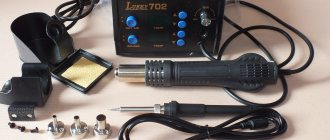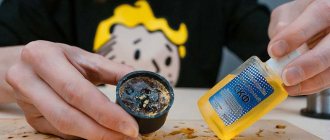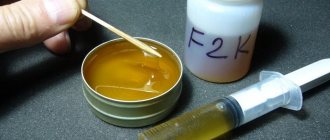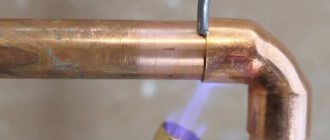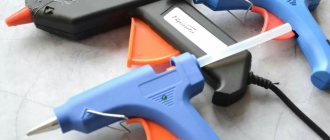Soldering guns are tools designed for soldering and welding. Hair dryers can be manufactured industrially or domestically; depending on this, they are divided into household and industrial. Household ones can have several operating modes: blowing, air supply mode without heating, etc. An industrial hair dryer has a larger range of modes. Household soldering guns can be purchased on Aliexpress.
The simplest soldering devices are housed in a plastic case, but more advanced models have rubberized handles and metal parts. To make it easier for you to decide on the choice of a soldering hair dryer, we have compiled a rating of the TOP 20 best soldering hair dryers from Aliexpress.
Solder Paste Reviews
Solder paste is a substance that is used in the soldering process instead of regular rosin; it contains solder powder, flux, some kind of binder and some other components.
The main selection parameters: • its composition – solders with alloying additives, with or without lead content, and so on; • the size of individual solder particles and shape, depending on this there are different dosages; • viscosity level - the method of application depends on this - using a stencil or dispenser; • solderability - determined by the contamination of the particles and the level of their oxidation.
In addition, such pastes may not be subject to corrosion - no-clean. Rust may form in soldering areas, since water-washable pastes contain organic substances. For high-quality soldering, you need to choose a paste depending on the metal with which it will be used. There are special compositions for chrome-nickel, copper, aluminum, gold, and silver.
I bought it because of the title “solder paste” and, accordingly, I expected to receive exactly solder paste in the classical sense - a mixture consisting of flux mixed with highly crushed solder particles, which is very convenient. When I opened the jar, it became clear that this was not the same paste, but only a flux, and very similar in appearance to the bad Chinese flux RMA-223. But after trying it at work, I was pleasantly surprised. However, there are some nuances that you need to be aware of. That's all we'll talk about in the review.
Today's review will be devoted to the MECHANIC XG-50 (XG-500) solder paste, which I purchased on eBay. I had a desire to acquire soldering paste for a long time, but since my tool assortment did not include a soldering gun, this purchase was constantly pushed into the background. But after I came across a budget technical hair dryer, I decided to purchase solder paste along with it. The choice was made spontaneously, mainly based on data from the seller’s pages, and fell on MECHANIC XG-50 paste.
Source
Is it necessary to clean the boards after soldering from flux residues?
In general, it is advisable to clean the board after soldering, unless we are talking about protective fluxes. If you soldered with acid, then this is absolutely necessary.
Sometimes you even need to clean the soldering area from rosin. And not only for beauty, but also to make sure that there is no excess solder on the contacts, which could cause a short circuit on the board.
Removing residues
For cleaning the board after soldering, products such as Galosh gasoline, isopropyl alcohol, Flux Off and white spirit are excellent.
You can also use medical alcohol or vodka, but of course they clean much worse.
Cleaning can only be done in a ventilated area!
Use a small jar with a small hole (or dispenser) to store gasoline so you don't have to constantly open and close bottles. For example, you can use a hydrogen peroxide bottle.
They also sell these special bottles with different needles. They make it very convenient to dose the cleaning product.
It will be enough to tilt the container and apply a small dose of cleaning agent to the electronic board.
It is convenient to clean the board using cotton swabs, discs or a regular toothbrush.
It is not recommended to clean solder residues with water, even if the manufacturer allows it. A mixture of water and flux residues is very difficult to dry. Especially when it comes to BGA.
What is SMD and basic principles
The use of flux for soldering SMD components has its own characteristics, which make it possible to improve the connection of the surface of microcircuits and boards. General recommendation for using flux for soldering SMD is effective for chip resistors, as well as SOIC, LQFP, QFN and others. The application of the thinnest layer of material allows for production soldering without compromising quality. By the way, literally from English the meaning of SMD soldering paste is translated as “using components for surface soldering” (Surface Mounted Devices). As can be seen from the working name of the paste, it allows for sufficient assembly density of the connection compared to conventional technologies.
SMD component soldering process
Most craftsmen mistakenly believe that using SMD components is impractical at home. Most craftsmen believe that only TN technology can be needed at home, although the main problem is choosing the correct diameter of the soldering iron tip. Inexperienced craftsmen really do not know the intricacies of using SMD soldering with solder paste, since the result of the work is “staining” of SMD contacts on the printed circuit board with tin. To avoid typical mistakes, some parameters should be taken into account: capillary effect, which must have a fine structure, as well as surface tension and proper wetting of the surface being treated. Ignoring the tasks at hand will not be able to fully answer the difficult question of which flux is best for soldering SMDs at home or on an industrial scale.
High-quality contact with the legs of the microcircuit of the board with SMD components occurs for one simple reason, the effect begins to be exerted by the general tension force, which forms separate independent drops of tin formation on the surface of the board.”
As can be seen from the general description, the wizard’s actions are minimized and the flux for soldering SMD components only heats the legs of the microparts used. Remember, when working with very small components and parts, seizing (unexpected connection) of technological elements to the tip of a working hot soldering iron may occur, which negatively affects the further operation of the microcircuit.
UPDATE:
Another test for the neutrality/activity of fluxes under the influence of heating with a soldering iron and subsequent cooling (thanks to u3712 for the idea), once again proving the need to wash off fluxes after work. I made a blank where I soldered two wires side by side so that each occupied 2 spots, threading two holes in the board according to the principle of sewing fabric with threads.
I connected the probes of the tester, which was turned on in resistance measurement mode, to the other ends of the wires.
Features of technology in factory conditions
For industrial production, soldering paste for SMD components is adapted to a group system, which uses an electronic system for applying flux to the surface of the microcircuit. Fine application technology using silk-screen printing is used on the surface of contact working areas. Thus, in its technology and consistency, the material somewhat reminds us of the usual toothpaste. The substance includes solder powder, as well as flux components. The entire substance is mixed and applied to the surface of the microcircuit using a conveyor method.
Appearance of paste for SMD
An automated system carefully turns over the boards that need to be soldered, then the microcircuits are moved to a temperature cabinet, where the mass spreads, followed by solder. In the oven, under the influence of the required temperature, a conditional flow occurs around the technological contact legs of the SMD components, and as a result, a fairly strong connection is obtained. After the temperature cabinet, the chip is again moved to a natural environment, where cooling occurs.
Is it possible to solder with SMD paste yourself?
Theoretically, yes, but in practice, quite a lot of experience is needed to carry out this technological operation. For work we will need the following tools and preparations:
The flux should always be in a liquid state, this way you completely disinfect the surface of the microcircuit. In addition, the drug removes the formation of oxides on the surface of the board during operation. Remember that an alcohol solution together with rosin cannot ensure the quality of soldering, and their use is only permissible if a suitable soldering compound is not available.
Soldering iron selection
To work, you need to select a special soldering iron that has an adjustable heating range. To work with the microcircuit, a soldering iron is suitable, which has an operating heating temperature of no more than +250...+300 C. If you do not have such a soldering iron at hand, you can use a device with a power of 20 to 30 W and no more than 12-36 Volts.
A soldering iron with a voltage of 220 Volts will not be able to ensure the quality of soldering, where it is very difficult to regulate the required heating temperature of the flux.
Soldering iron for soldering SMD components
We do not recommend using a soldering iron with a cone-type tip; this will lead to damage to the surface being processed. The most optimal tip is the “microwave” type. A soldering iron with a voltage of 220 Volts not only heats up quickly, but also leads to volatilization of components during the soldering process. For efficient operation of the soldering iron, we recommend using the thinnest wire to ensure interaction between the tip, flux and solder.
But, for a microcircuit, the soldering procedure is slightly different from the above:
In some cases, it is possible to use a special soldering gun for soldering, but for this it is necessary to create appropriate working conditions. Remember that the hair dryer can only be heated to a temperature of +250 C, no more (in rare cases, up to +300 C).
Source
The essence of the process
The essence of the soldering process is that metals are joined together using an alloy that has a melting point lower than the melting point of the substances being joined.
During soldering, materials are heated to the melting temperature of the solder. This ensures very strong adhesion (sticking) - the property of materials to adhere to each other at the molecular level.
However, the main parts do not melt and mix with the solder material, as happens when welding using filler material.
Solder paste and its properties
Initially, such compositions were used only in SMT technologies. Now their area of use has increased. Solder paste for SMD contains the following ingredients:
It is possible to achieve high-quality soldering only in a situation where all conditions and shelf life of the solder mass have been met. Most of the ingredients in such formulations have a shelf life of no more than six months. They should be stored at a temperature of +2…+10°C. The room should not be too cold or hot. The air humidity level should not exceed 80%. Before using the composition, it must be warmed to room temperature and only then open the jar or remove the substance from the syringe. In some cases, it takes about 5-6 hours to warm up.
It is also necessary to take into account that over time the solder mixture loses its properties. It is necessary to select materials for soldering with tin or other materials taking into account the following requirements:
In addition, solder paste materials must be easy to dispense and suitable for screen printing.
Kingbo 218
Exactly the same procedure, with a different flux - 218, which has already shown its activity, according to the test above, by oxidizing copper contacts, which after a while turned green. I applied a little flux between the two contacts. He applied a heated tip. A resistance of tens of megohms appeared, which began to decrease as it warmed up to about unity, and around 1 megohm the value continued to fluctuate slightly.
We remove the tip - the resistance begins to increase as it cools, up to tens of megohms and up to infinity.
Important Specifications
Solder mass must be selected taking into account its physical and chemical properties. These characteristics are directly dependent on the ingredients of the composition. These properties are:
In addition, no-clean pastes do not provoke the formation of corrosion, while water-washable pastes can lead to such problems at the soldering site, since they contain a number of organic substances.
RMA-223
First I smeared RMA-223
between the two contacts. I applied the heated soldering iron tip to the edge of one of the contacts so as not to short them, the flux melted and I looked at the tester. As infinity was, so it remains.
I removed the soldering iron and allowed the workpiece to cool - also no change. Flux is neutral.
Making at home
Sometimes ready-made solder paste is not available, so it is useful to learn about how to make it. For this purpose, it is necessary to prepare soldering fat and a solder rod made of lead and tin. If the first material is not available, it can be replaced with Vaseline LTI-120.
The solder must be crushed using a needle file or a special drill attachment. The finished crumb should consist of small particles. It is put into a container into which Vaseline is added in a 1:1 ratio and a small amount of flux.
All components of the homemade paste are thoroughly mixed and heated in a water bath. The finished composition can be stored in a large syringe. With the help of it, a paste-like substance will be applied to the boards.
Examples of using fluxes and soldering PIC solder of various metals
A variety of fluxes is available due to different soldering requirements and temperatures. Some metals require a different approach to soldering and tinning. Soldering can be either low-temperature or high-temperature.
Black metals
Such metals are usually soldered using zinc chloride or ammonium chloride.
Soldering electrical equipment (DIP, BGA, SMD, boards and wires)
As mentioned on the page above, the main requirements for fluxes when soldering electronics and electrical equipment are low leakage current and lack of corrosive activity. Rosin, solder fat, LTI-120, FECT, RMA-223, etc.
Aluminum alloys
Aluminum can be easily soldered with both rosin and LTI-120, but this is in cases of small contacts. If the soldering surface is too large, it is better to use acid-based fluxes. For example, it could be orthophosphoric acid.
Stainless steel
Phosphoric acid can also be used for soldering stainless steel.
Fluxes for high temperature soldering
For higher temperature soldering (about 800-1150ºC) boric acid, borax and similar impurities are suitable. The solder used is usually copper-zinc and silver.
Application benefits
Solder pastes are used not only in everyday life, but also in industry. Such widespread distribution of this material is explained by its following advantages:
If there is no opportunity or desire to make the mixture yourself, you can purchase a ready-made version. But you need to remember that high-quality solder paste costs about 10 US dollars per 50 g. Cheaper options are of poor quality and may not only not provide sufficient fixation reliability, but also lead to additional problems during subsequent use of the electronic product. To avoid problems, it is better to buy such materials in certified stores or directly from manufacturers.
Source
Soldering iron selection
So, let's start with the fact that the soldering iron is the most basic part of the soldering process.
The speed and ease of doing the job depends on the correct choice of this tool. Electric soldering irons are divided into 2 types:
- Spiral. Spiral ones heat up slowly, but are more durable.
- Ceramic. Ceramic ones, in turn, heat up quickly, but require careful use, as they are very susceptible to mechanical stress.
Also, the device is divided by power:
- 3-10 W, mainly used when desoldering microcircuits of very tiny sizes;
- 20-40 W, in demand among radio amateurs and at home;
- 60-100 W, with their help solder wires with a large cross-section;
- 100-250 W, for working with large-sized metal;
Mostly, experienced soldering stations use soldering stations as they are equipped with an adjustable heating range and are able to maintain a constant temperature. A soldering station in the hands of a master greatly speeds up and improves the work process, but a beginner, unfortunately, will not be able to feel the benefits.
There are a certain number of characteristics by which soldering irons differ:
- Soldering iron supply voltage.
- Shape of the sting.
- Maximum tip temperature.
We must not forget about such an important thing as a soldering iron stand. It heats up to three hundred degrees and any mistake can lead to immediate combustion of flammable materials. It is necessary to very responsibly choose the necessary stand that fully fits the existing soldering iron.
Solder paste for smd which is better with solder
Mikhail Nizhnik
, General Director, METTATRON Group LLC
The author summarizes information about the properties and behavior of solder pastes during soldering, based on extensive experience working with solder pastes. The article will be of interest to a technologist working on a surface mounting line.
Types of solder pastes
Pastes are classified according to the type of flux (see Fig. 1).
“Water-soluble” solder paste (flux residues after soldering are dissolved with water), which requires mandatory cleaning due to the content of active flux (see Table 1), is washed sequentially with ordinary, distilled and deionized water, and at each stage jet cleaning or ultrasound is used. For “water-soluble” pastes that do not require mandatory cleaning, the process is limited to distilled water.
Rice. 1. Classification of solder pastes
Table 1. Classification of fluxes
| Flux activity (% halogen content) | Rosin (RO) | Synthetic Resin (RE) | Organic Organic (OR) | The need for washing |
| Low (0%) | ROL0 | REL0 | ORL0 | No |
| Low (2.0%) | Necessarily |
With pastes that require cleaning with special liquids, the situation is different. Regardless of the presence of halogens in the composition, such pastes are based on rosin fluxes, therefore, to clean them after soldering, it is recommended to use a solvent such as HCFC and a saponifying reagent. Then the cleaning liquids, in turn, are washed with distilled and then deionized water.
However, many halogen-free solder pastes are difficult to clean and leave a whitish flux residue on the surface of the boards. In this case, resistance to sediment is considered more important than washability.
Most no-clean solder pastes eliminate this process from production. The fluxes of such pastes protect the soldered joint from corrosion like varnish. Let's focus on pastes that do not require cleaning: they are the most technologically advanced.
Rice. 2. Composition of solder pastes
It is often said that no-clean pastes must be halogen-free. It must be clearly understood that if the documentation for the paste states “Requires washing,” then it must be washed, and if there is no such marking, then the issue is resolved based on additional requirements for the product: appearance, application of varnish.
In Japan, for example, halogen-containing pastes (0.2%) in processes without cleaning after soldering are much more popular than halogen-free ones. Halogen-containing solder pastes are comparatively more technologically advanced, for example, in terms of solderability, but are often inferior to halogen-free pastes in terms of reliability, which is manifested in a decrease in the insulation resistance of the finished installation. This is explained by the higher chemical activity of flux residues. Thus, solderability and reliability, in most cases, are mutually exclusive factors.
Rice. 3. Main characteristics taken into account when developing or selecting solder pastes
Ideally, for no-clean soldering you need a halogen-free paste, but with the solderability of a halogen-containing paste.
The difficulty lies in increasing the chemical activity of halogen-free no-clean pastes. In most of these pastes, organic acids are used as an activator instead of halogen-containing compounds, and the lower the molecular weight of the acid, the greater the activation ability. Since the activating effect of organic acids is much weaker than that of halogen-containing components, they try to introduce a couple of dozen relatively active organic acids into the flux system.
At the same time, such highly active organic acids absorb moisture. This is fraught: the acid remaining in the flux residues on the surface of the substrate is ionized when interacting with water, which reduces the surface insulation resistance and leads to electromigration.
Activation systems in solder pastes (here the author relies on technical data on pastes) use less hygroscopic organic acids and a specially developed non-ionic activator. This special system does not dissociate into ions, its electrical properties are stable, and its activating ability is not inferior to halogens. Due to the high activation temperature, the non-ionic activator in combination with carefully selected organic acids makes the activation at the reflow stage longer. As a result, solderability is improved without sacrificing reliability.
Here are examples of popular types of pastes:
Composition of solder pastes
Solder pastes consist of solder and flux (see Fig. 2). When choosing a solder + flux complex for solder paste, take into account the characteristics shown in Fig. 3.
Gas and centrifugal atomization methods are used to produce solder powder. Features of the gas atomization method:
— obtaining small particles;
— ease of control of the process of formation of an oxide film on the surface of particles;
— low level of oxidation of solder particles.
The resulting solder powder particles range in size from 1 to 100 microns. The size distribution of solder particles and their diameter are influenced by solder feed speed, spindle speed and oxygen content.
Rice. 4. Obtaining solder powder by gas atomization
The powder is obtained in a container about 5 m high and 3 m in diameter, which is filled with nitrogen and oxygen of very low density (see Fig. 4). The solder ingots are melted in a crucible located at the top of the tank. Molten solder drips down onto the spindle, which rotates at high speed. When drops of solder hit the spindle, the solder splashes towards the walls of the reservoir, causing the solder to become spherical and solidify before the particles reach the wall of the reservoir.
Rice. 5. The degree of oxidation of solder particles depending on their size
The solder powder then goes to the sorting screen, where it is best to use the double sorting method of solder powder. At the first stage, the powder is sorted by a stream of nitrogen from a blower. In this case, particles with sizes smaller than the required size are eliminated. Then the powder goes to a sieve, where particles with sizes exceeding the specified values are retained.
Solder pastes with a particle size of 20–38 microns are used for mounting printed circuit boards with a stencil aperture pitch of up to 0.4 mm, and with a particle size of 20–50 microns for pitches of 0.5 mm.
The quality of powders is influenced by two factors.
Particle size distribution affects solder paste rheology, printability, flow, stencil release behavior, and paste slump performance. The minimum size of the stencil apertures depends on the minimum size of the pads on the printed circuit board, with the maximum size of the aperture being less than or equal to the size of the pad. Select the required particle size on the basis that at least 5 particles of solder should be guaranteed to fit into the smallest aperture of the stencil, as shown in Fig. 12.
The second component of solder paste is flux. The role of flux in solder pastes is the same as in wave soldering, or selective soldering. The flux should:
— remove the oxide film and prevent re-oxidation during the soldering process. Metal surfaces at high temperatures during melting quickly oxidize. At these temperatures, the solid components of the flux soften and turn into a liquid state, covering and protecting the soldered surfaces from re-oxidation. Flux restores metal and removes oxide film from the surface of contacts of electronic components, the final coating of the printed circuit board and the surface of the solder powder;
- remove dirt. However, flux will not cope with a large number of sweat and grease marks, so it is better to handle the board with gloves;
— ensure the stability of the paste viscosity required during printing and reflow.
The main fluxing components and their role are indicated in Table 3.
Table 3. Main fluxing components and their role
| Group | Substances | What are they influenced by? | Explanation |
| Activators | Amine hydrochloride. Organic acids, etc. | Activating ability (solderability). Reliability (surface resistance of flux residues, level of electromigration and corrosion). Shelf life. | It is these components that mainly ensure effective removal of oxides. Activators not only soften and liquefy wood resins, they also wet the metal surface and react with oxides. |
| Rosin | Wood rosin. Hydrogenated rosin. Disproportioned rosin. Polymerizing rosin. Rosin denatured with phenol. Rosin denatured with ether. | Seal. Solderability. Resistance to sediment. Stickiness. Color of flux residues. Traceability. | These types of rosin soften during the preheating stage (softening temperature 80–130°C) and spread over the surface of the solder particles and over the substrate. usually uses natural wood rosins. Depending on the type of processing, they have different colors (most often yellow or yellow-orange), activating ability and softening point. To control technological properties (sediment resistance, adhesiveness, etc.), as well as the properties of the residue (its color, plasticity, ability to ensure circuit testability), the flux usually includes at least 2-3 different types of rosin. |
| Thixotropic materials | Beeswax. Hydrogenated castor oil. Aliphatic amides. | Print clarity. Viscosity. Thixotropy. Resistance to sediment. Smell. Launderability. | These components help ensure the paste's resistance to shear stresses encountered during printing and installation of components on the board, and restore the viscosity of the paste after it is applied to the substrate. Additional components ensure easy separation of the paste from the stencil, which improves print quality. |
Let us now consider the factors affecting print quality.
Rice. 6. Factors affecting print quality
TESTS
First, I decided to check the consumables for oxidation by applying each flux to a 2x3
on the breadboard: columns
AB - RMA-223, DE - Kingbo 218, GH - NC-559
. After which the board went to lie on the cabinet, every few days I took it out from there and took a picture. The total testing time took about a month. I noticed that many people like to ask why they need to wash off flux; the last photo in this series of pictures will clearly explain why.
It can be seen that flux 559 (UV TPF)
more active than
218
,
223
did not show any effects.
The smell and density of the smoke
RMA-223
- in its usual form, for the first time after receipt, had an uncharacteristically culinary smell, namely the smell of some spices that are used to season dishes.
Then this smell changed to neutral. There is also no pronounced odor when soldering. There is little smoke. Kingbo 218
has a pleasant fresh smell in its usual form, but when soldered, it becomes disgusting along with a large amount of smoke.
NC-559
has a light, unobtrusive chemical smell; it doesn’t really catch your nose, but when you start soldering, you realize how disgusting it is.
There is about the same amount of smoke as the 218
.
To remove vapors and smoke, I use a corrugated hood from an air conditioner, with a cooler I later integrated that works to blow air out of the room. The second end of the pipe is brought out the window.
NC-559
The flux also showed its activity, which oxidized and greened the copper coins on the board even faster and more intensely than the 218th
flux.
I apply flux, apply the tip, heat it up. The resistance drops to 0.2 MOhm, but then rises and settles around 1.7 MOhm.
I'm removing the sting. It's cooling down. Resistance is rising.
================================================================
